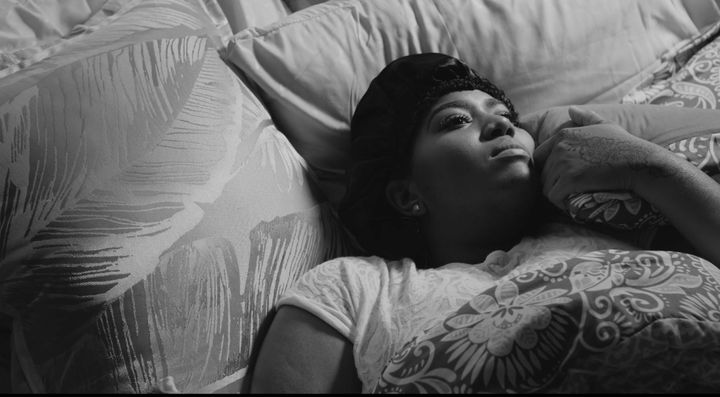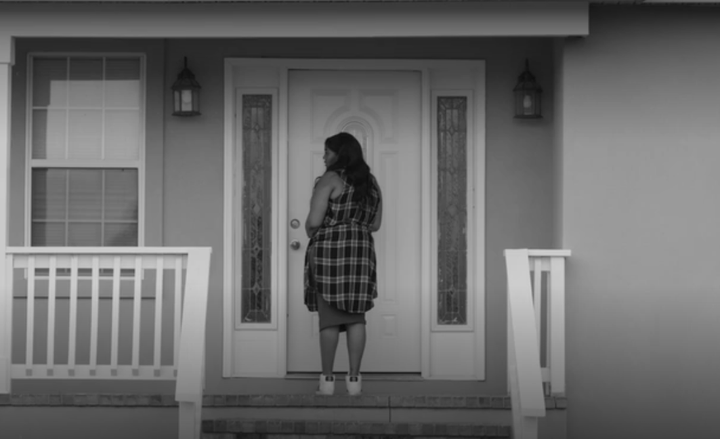
We meet Alone Watts during one of her most vulnerable moments. She’s lying in bed by herself, atop a heap of pillows, as the bonnet that protects her hair sits snugly against her forehead. The camera follows the single mother as she tosses and turns, staring at the ceiling, contemplating what may be the biggest decision of her life.
“What would it look like to marry Desmond in prison?” Watts wonders. “Feeling that you’re alone. Knowing that you’re alone ― that’s the scary part.”
Watts is the centerpiece of “Alone,” a 13-minute short film by New Orleans-based artist and filmmaker Garrett Bradley. The meaty documentary won the Short Film Jury Award: Non-fiction at this year’s Sundance Film Festival and premiered Tuesday on the New York Times’ Op-Docs.
The film, set in New Orleans, uses the long-distance relationship between Watts and her fiance, Desmond Watson, to explore the connections between the systematic separation of black families for the past 400 years ― starting with African enslavement ― and the current prison-industrial complex. Watts began dating Watson about two years ago, and he has been incarcerated for over a year as he awaits trial.
Louisiana, often called “the prison capital of the world” incarcerates more people per capita than China and Russia. Black men, like Watson, are disproportionately affected and are locked up at a rate of 362 per 100,000 ― over five times the rate of white men ― according to The Sentencing Project.
Bradley noted that our thoughts about mass incarceration are often rooted in these numbers, which causes us to overlook the people affected by the system and how it shapes their lives.
“We need to have more opportunities for people to connect on an emotional level to those facts,” Bradley told The Huffington Post. “It isn’t always the facts.”
Bradley gives us a look into Watts’ daily sense of disempowerment and shame while unpacking the stigma of marrying a man who’s in jail. We’re forced to question assumptions we may have about women who marry incarcerated men, and to reckon with the fact that Watts’ man has been snatched from her in a continuance of a sick tradition meant to undermine black families.
The desire for a legalized union between Watts and Desmond then becomes symbolic. Watts is a black woman who has the opportunity to grasp a form of power not typically afforded to them. No matter how loaded her decision may be, she’s seizing her right to get married on her own terms.
“Alone considering marriage was less about being a wife in this typical sense of playing a role,” Bradley said. “It really became more of this symbolism of allowing yourself a right that’s been taken from you for the past 400 years.”

In a second scene of extreme vulnerability in the film, Watts is seen entering a house. Once inside, she takes a deep breath and says, “I was coming here to tell ya [on] Saturday me and Desmond getting married.”
“Girl, why you marrying a n***a in jail,” shouts her mother. “What is it about fuckin’ Desmond that you got to marry fuckin’ Desmond in jail?”
Watts’ grandmother soon joins the conversation, saying her “heart is sad.”
“That’s a bad decision,” her grandmother says. “What point is it? What it’s gon’ do for y’all? What it’s gon’ do for you?”
For Bradley, it was important that people hear this conversation, which happened off camera.
“All of that anger and aggressiveness can be looked at, from one perspective, as a form of abuse, but it also can be looked at as a form of deep love and fear,” she said. “Spending a very long time trying to protect your child from a system and realizing that there’s other ways for them to participate … without them even doing anything wrong.”
When Watts leaves the house with her head hanging, fighting back tears, the viewer can sense her shame and agony ― which is exactly what Bradley wanted.
“When we see Alone leave that house, it really brings home the idea of loneliness,” Bradley said. “You really have very few people that you can turn to when you are in this kind of situation and that is something that I hope can change because loving somebody ― love should be equal, you know?”
Bradley’s exploration of how mass incarceration plays out in black female relationships continues as she shows a conversation between Watts and a woman who truly understands her reasoning for wanting to marry an incarcerated man.
“This system breaks you apart. It is designed just like slavery to tear you apart. And instead of using the whip, they use Mother Time. They use hardships,” says Fox Rich, a mother of six whose husband has been incarcerated for 20 years.
“They may not hang you from the tree but the experience itself is just like when they used to hang people … and leave their feet just tiptoeing around in the mud so that they’re constantly on their tiptoes fighting for their life — that is a daily experience when you are an incarcerated family,” she continues.
Bradley wants us to see Watts having these cross-generational conversations with other women about what it means for her to bind herself to being married to an incarcerated man. “She’s really at the infancy of the possibilities,” Bradley said.
“Alone” captures generations of trauma and the deep vulnerability and shame that black women are forced into when they become intertwined with the prison system. Bradley hopes that, ultimately, the film will alleviate the stigma associated with being in a relationship with someone who is incarcerated.
Watch the entire film above.

